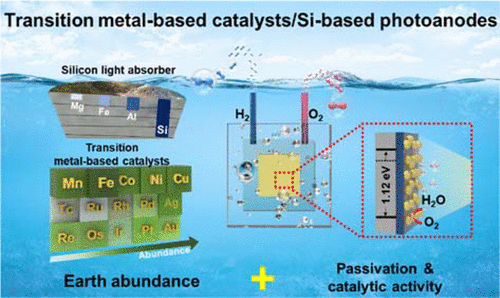当前位置:
X-MOL 学术
›
ACS Mater. Lett.
›
论文详情
Our official English website, www.x-mol.net, welcomes your
feedback! (Note: you will need to create a separate account there.)
Si-Based Water Oxidation Photoanodes Conjugated with Earth-Abundant Transition Metal-Based Catalysts
ACS Materials Letters ( IF 9.6 ) Pub Date : 2019-12-12 , DOI: 10.1021/acsmaterialslett.9b00422 Sol A Lee 1 , Seokhoon Choi 1 , Changyeon Kim 1 , Jin Wook Yang 1 , Soo Young Kim 2 , Ho Won Jang 1
ACS Materials Letters ( IF 9.6 ) Pub Date : 2019-12-12 , DOI: 10.1021/acsmaterialslett.9b00422 Sol A Lee 1 , Seokhoon Choi 1 , Changyeon Kim 1 , Jin Wook Yang 1 , Soo Young Kim 2 , Ho Won Jang 1
Affiliation

|
The development of a carbon-free hydrogen production method by photoelectrochemical water splitting is a promising pathway to deal with the increased energy demands and deleterious environmental issues derived from the usage of fossil fuels. Silicon, which is the second most earth-abundant element and a small band-gap material, is an applicable candidate for an efficient solar water splitting photoelectrode. However, the stability of Si-based photoelectrode hampers efficient water splitting, especially for the Si-based photoanodes because of its thermodynamic instability and etching of silicon surface. Until now, much research has been conducted to deal with the challenges of using Si to fabricate efficient and stable photoanodes. Over the decades, to expedite the oxygen evolution reaction, a complicated 4-electron transfer process and requires large overpotential, cheap and earth-abundant transition metal-based electrocatalysts have been investigated. In this Review, we briefly introduce the photoelectrochemistry and important parameters for evaluating the performance of the Si photoanodes. We summarize transition metal-based catalysts, focusing on Ni-, Co-, and Fe-based oxygen evolving catalysts. Then, we present various strategies to overcome the challenges of silicon by combining the advantages of transition metal-based oxygen evolving catalysts, which are cost-effective, stable, and highly active for oxygen evolution reaction. Finally, to realize spontaneous water splitting, we introduce Si-based tandem cells combined with transition metal-based materials.
中文翻译:

硅基水氧化光阳极与富含地球的过渡金属基催化剂共轭
通过光电化学水分解法开发无碳氢生产方法,是解决因使用化石燃料而产生的能源需求增加和有害环境问题的有前途的途径。硅是地球上第二大元素,也是一种带隙小的材料,是高效分解太阳能光电极的适用候选材料。然而,基于硅的光电极的稳定性阻碍了有效的水分解,特别是对于基于硅的光阳极而言,因为其热力学不稳定性和硅表面的蚀刻。迄今为止,已经进行了大量研究来应对使用硅制造高效,稳定的光阳极的挑战。几十年来,为了加快氧气释放反应,已经研究了复杂的4-电子转移过程并且需要大的超电势,廉价且富含地球的过渡金属基电催化剂。在这篇综述中,我们简要介绍了光电化学和评估硅光电阳极性能的重要参数。我们总结了基于过渡金属的催化剂,重点介绍了基于Ni,Co和Fe的析氧催化剂。然后,我们提出了各种策略,通过结合基于过渡金属的析氧催化剂的优点来克服硅的挑战,这些催化剂具有成本效益,稳定且对析氧反应具有很高的活性。最后,为了实现自发的水分解,我们介绍了结合过渡金属基材料的硅基串联电池。已经研究了廉价且富含地球的过渡金属基电催化剂。在这篇综述中,我们简要介绍了光电化学和评估硅光电阳极性能的重要参数。我们总结了基于过渡金属的催化剂,重点介绍了基于Ni,Co和Fe的析氧催化剂。然后,我们提出了各种策略,通过结合基于过渡金属的析氧催化剂的优点来克服硅的挑战,这些催化剂具有成本效益,稳定且对析氧反应具有很高的活性。最后,为了实现自发的水分解,我们介绍了结合过渡金属基材料的硅基串联电池。已经研究了廉价且富含地球的过渡金属基电催化剂。在这篇综述中,我们简要介绍了光电化学和评估硅光电阳极性能的重要参数。我们总结了基于过渡金属的催化剂,重点介绍了基于Ni,Co和Fe的析氧催化剂。然后,我们提出了各种策略,通过结合基于过渡金属的析氧催化剂的优点来克服硅的挑战,这些催化剂具有成本效益,稳定且对析氧反应具有很高的活性。最后,为了实现自发的水分解,我们介绍了结合过渡金属基材料的硅基串联电池。我们简要介绍了光电化学和评估硅光电阳极性能的重要参数。我们总结了基于过渡金属的催化剂,重点介绍了基于Ni,Co和Fe的析氧催化剂。然后,我们提出了各种策略,通过结合基于过渡金属的析氧催化剂的优点来克服硅的挑战,这些催化剂具有成本效益,稳定且对析氧反应具有很高的活性。最后,为了实现自发的水分解,我们介绍了结合过渡金属基材料的硅基串联电池。我们简要介绍了光电化学和评估硅光电阳极性能的重要参数。我们总结了基于过渡金属的催化剂,重点介绍了基于Ni,Co和Fe的析氧催化剂。然后,我们提出了各种策略,通过结合基于过渡金属的析氧催化剂的优点来克服硅的挑战,这些催化剂具有成本效益,稳定且对析氧反应具有很高的活性。最后,为了实现自发的水分解,我们介绍了结合过渡金属基材料的硅基串联电池。我们结合过渡金属基析氧催化剂的优点,提出了各种克服硅挑战的策略,这些催化剂具有成本效益,稳定且对析氧反应具有很高的活性。最后,为了实现自发的水分解,我们介绍了结合过渡金属基材料的硅基串联电池。我们结合过渡金属基析氧催化剂的优点,提出了各种克服硅挑战的策略,这些催化剂具有成本效益,稳定且对析氧反应具有很高的活性。最后,为了实现自发的水分解,我们介绍了结合过渡金属基材料的硅基串联电池。
更新日期:2019-12-13
中文翻译:

硅基水氧化光阳极与富含地球的过渡金属基催化剂共轭
通过光电化学水分解法开发无碳氢生产方法,是解决因使用化石燃料而产生的能源需求增加和有害环境问题的有前途的途径。硅是地球上第二大元素,也是一种带隙小的材料,是高效分解太阳能光电极的适用候选材料。然而,基于硅的光电极的稳定性阻碍了有效的水分解,特别是对于基于硅的光阳极而言,因为其热力学不稳定性和硅表面的蚀刻。迄今为止,已经进行了大量研究来应对使用硅制造高效,稳定的光阳极的挑战。几十年来,为了加快氧气释放反应,已经研究了复杂的4-电子转移过程并且需要大的超电势,廉价且富含地球的过渡金属基电催化剂。在这篇综述中,我们简要介绍了光电化学和评估硅光电阳极性能的重要参数。我们总结了基于过渡金属的催化剂,重点介绍了基于Ni,Co和Fe的析氧催化剂。然后,我们提出了各种策略,通过结合基于过渡金属的析氧催化剂的优点来克服硅的挑战,这些催化剂具有成本效益,稳定且对析氧反应具有很高的活性。最后,为了实现自发的水分解,我们介绍了结合过渡金属基材料的硅基串联电池。已经研究了廉价且富含地球的过渡金属基电催化剂。在这篇综述中,我们简要介绍了光电化学和评估硅光电阳极性能的重要参数。我们总结了基于过渡金属的催化剂,重点介绍了基于Ni,Co和Fe的析氧催化剂。然后,我们提出了各种策略,通过结合基于过渡金属的析氧催化剂的优点来克服硅的挑战,这些催化剂具有成本效益,稳定且对析氧反应具有很高的活性。最后,为了实现自发的水分解,我们介绍了结合过渡金属基材料的硅基串联电池。已经研究了廉价且富含地球的过渡金属基电催化剂。在这篇综述中,我们简要介绍了光电化学和评估硅光电阳极性能的重要参数。我们总结了基于过渡金属的催化剂,重点介绍了基于Ni,Co和Fe的析氧催化剂。然后,我们提出了各种策略,通过结合基于过渡金属的析氧催化剂的优点来克服硅的挑战,这些催化剂具有成本效益,稳定且对析氧反应具有很高的活性。最后,为了实现自发的水分解,我们介绍了结合过渡金属基材料的硅基串联电池。我们简要介绍了光电化学和评估硅光电阳极性能的重要参数。我们总结了基于过渡金属的催化剂,重点介绍了基于Ni,Co和Fe的析氧催化剂。然后,我们提出了各种策略,通过结合基于过渡金属的析氧催化剂的优点来克服硅的挑战,这些催化剂具有成本效益,稳定且对析氧反应具有很高的活性。最后,为了实现自发的水分解,我们介绍了结合过渡金属基材料的硅基串联电池。我们简要介绍了光电化学和评估硅光电阳极性能的重要参数。我们总结了基于过渡金属的催化剂,重点介绍了基于Ni,Co和Fe的析氧催化剂。然后,我们提出了各种策略,通过结合基于过渡金属的析氧催化剂的优点来克服硅的挑战,这些催化剂具有成本效益,稳定且对析氧反应具有很高的活性。最后,为了实现自发的水分解,我们介绍了结合过渡金属基材料的硅基串联电池。我们结合过渡金属基析氧催化剂的优点,提出了各种克服硅挑战的策略,这些催化剂具有成本效益,稳定且对析氧反应具有很高的活性。最后,为了实现自发的水分解,我们介绍了结合过渡金属基材料的硅基串联电池。我们结合过渡金属基析氧催化剂的优点,提出了各种克服硅挑战的策略,这些催化剂具有成本效益,稳定且对析氧反应具有很高的活性。最后,为了实现自发的水分解,我们介绍了结合过渡金属基材料的硅基串联电池。











































 京公网安备 11010802027423号
京公网安备 11010802027423号